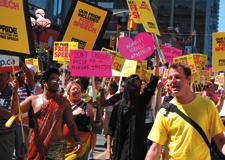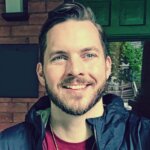As late-afternoon patrons lazed on a Church-Wellesley patio on July 9, a group of activists straggled in. They weren’t the usual boozey, after-work set, with their shaggy haircuts and hairless arms.
The mild-mannered Michael Went was there, as was larger-than-life Roy Mitchell. Jane Walsh, with her trademark squarish pink glasses, sat at one end of the long table. On average, it was an older crew, not serious partiers.
They met to discuss the future of the Pride Coalition for Free Speech, to talk about how to keep the ball rolling, and how to infuse future Pride celebrations with the spirit of activism evident in 2010.
>> Free speech at Toronto Pride: Read all of Xtra‘s coverage in one place
A question hung in the air: how should they best harness all the energy and goodwill generated in the previous month?
Over the spring, the group had coalesced gradually. It started with Walsh and Doug Kerr, Went’s husband. Before the controversy, Walsh and Kerr spent the winter planning Pride Toronto’s (PT) official human rights programming.
At first, they must have seemed an odd couple. Walsh, a labour activist, and Kerr, a straight-laced consultant, came from different sides of the political track. But they came to represent the cross-community cooperation that became a hallmark of the coalition’s work.
Shortly after the PT board of directors announced its sign-vetting policy in March, Walsh and Kerr ran into each other — by accident — at Starbucks. They both thought the policy was a bad idea and agreed to work together.
By then, Elle Flanders and Queers Against Israeli Apartheid (QuAIA) were already mobilizing opposition. In London, Ontario, Rick Telfer was whipping queers up on Facebook through the Don’t Sanitize Pride Facebook group.
Walsh and Kerr organized a meeting with PT executive director Tracey Sandilands. Then they pulled together a larger group – primarily artists — to talk to PT co-chairs Genevieve D’Iorio and (at the time) Jim Cullen.
Walsh reached out to video artist Roy Mitchell and writer Farzana Doctor. Kerr brought DJ and lawyer Zahra Dhanani on board. Shortly after their meeting with the co-chairs, the sign-vetting policy, including its Orwellian ethics committee, disappeared.
But sensing there was still trouble brewing — especially after a scolding letter to PT from city councillor Kyle Rae was leaked — they continued to bring people in. They called on playwright Brad Fraser, former PT board member Mark Smith and musician Troy Jackson.
“I knew we had trouble on our hands; we knew,” says Walsh.
“At the same time too, we were incredulous that we’d have to do anything,” adds Mitchell.
But sure enough, PT announced on May 25 that it would ban the term “Israeli apartheid.” By then, the coalition was ready and was able to organize a meeting quickly at The 519. A Facebook page went up with a laundry list of groups participating. It was the first time most had heard of the Pride Coalition for Free Speech.
“A lot of the work that happened behind the scenes — people kind of think that it came together overnight,” says Walsh.
Xtra has spilled a lot of ink on what happened next: 400 people showed up to the first coalition meeting; it spiralled off into two subsequent planning meetings and a host of Pride Week events. Over that period, queers marched on the PT offices twice, more than 20 people gave back their PT honours and a vigorous letter-writing and PR campaign was hatched online.
The coalition’s decision-making was based on whoever showed up at meetings. Subgroups were struck to plan events, and suddenly there were dozens of people working in concert.
“I don’t think anyone wanted to do everything; I don’t think that’s humanly possible,” says Mitchell. “But what it comes down to is a faith in people and a belief in the history.”
Dhanani concurs.
“Every one of us thought that we needed as much help as we could get,” Dhanani says. “That’s how amazing this organizing has been — it was different than everything I’ve ever been involved in. It wasn’t about power and control; when those conversations came up, we shut them down right away.”
Of course, this gaggle of activists are the tip of the iceberg. In building a movement, they were riding a wave of popular sentiment in queer circles. No matter how people felt about the Middle East, or QuAIA, there was a sense that the censorship tack taken by PT wasn’t the right one.
“They had great networks, and they knew how to work Facebook,” adds Jane Farrow, who in June declined to be PT’s honoured dyke. In doing so, she became a face for the so-called Refuseniks.
“But that reduces it to who was the bigger kid in the playground; their ideas had more merit,” she says. “Those ideas had more sway.”
They were also able to tap into other frustrations that had been laying dormant for years. For some, censoring QuAIA was the latest in a string of concessions made in the name of safety and financial security.
At meetings, folks spoke of a time before parade spectators were cordoned off behind barricades. Others, like fellow Refusenik Sky Gilbert, yearned to return to more overt expressions of sexuality (rather than just toned bodies).
Others had more specific gripes. The treatment of Blackness Yes, which organizes Pride’s most visible nod to people of colour, was a recurring motif.
Farrow and others criticized the PT artists’ agreement, which forbids political speech from the stage.
So when the ban was rescinded, Walsh, Dhanani, Mitchell and the rest of the gang didn’t disband. Rather, they made the tone of the events they were planning — a picnic, a panel discussion, their parade entry — more joyful, but they carried on.
The People’s Gala, originally planned as a stormy protest at the entrance to PT’s $350-a-plate fundraiser, became a love-in. Even the location changed; rather than meeting in front of The Carlu, Dhanani moved the event to the corner of Church and Maitland.
In part, they wanted to etch the censorship battle permanently into the minds of the week’s revellers. There was also a sense, says Dhanani, that the campaign was snowballing.
“We didn’t want to lose the momentum. We were mobilizing more and more people,” she says. “It was a celebration of our success. And out of the campaign, we grew the kind of Pride that we had been craving for the last decade.”
So then, what of the early-evening, post-Pride meeting? What’s next for the Pride Coalition for Free Speech? There is still work to be done on several of the group’s projects, including democratic renewal and a return to a community focus at next year’s festivities.
By using the flat political model the group espouses, they’re throwing that question back to the queer community.
Whatever the outcome, coalition organizers believe the tenor of future Pride celebrations is at stake.
“There will always be room for squirt guns and beads and stilettos and motorcycles at Pride,” says Farrow. “Will there always be room for politics? That’s the question.”


 Why you can trust Xtra
Why you can trust Xtra


